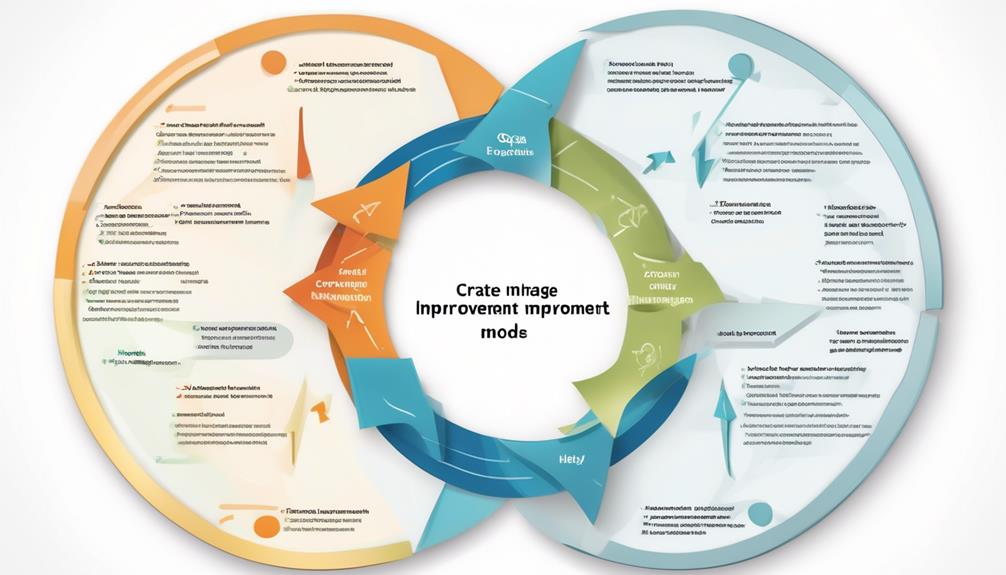Certainly, individuals often mention how “practice makes perfect,” right? This adage absolutely rings true in the field of Software Quality Assurance (SQA). Continuously aiming for betterment is crucial. Adhering to the best industry practices significantly enhances the quality of a product.
From agile methodologies to quality management tools and continuous integration, the possibilities for improvement seem endless. But how does one navigate through these practices and implement them effectively?
Join me as I explore the key tips, benefits, and a continuous improvement model tailored specifically for SQA, shedding light on fostering a culture of improvement within a team.
Key Takeaways
- Swiftly adapt to market changes
- Deliver flawless products
- Maintain high-quality standard
- Foster a culture of quality
Importance of Continuous Improvement in SQA
Continuously improving software quality assurance is essential for organizations to swiftly adapt to market changes and deliver flawless products in the digital landscape. The importance of continuous improvement in SQA can't be overstated.
Embracing best practices in software quality, QA processes, and test automation is crucial for maintaining a high-quality standard in products and services. A well-defined quality management plan, coupled with effective communication between teams, is vital for achieving this.
In an active product development cycle, the focus on improving processes is paramount. This entails implementing viable strategies, scenario analysis, and test data identification to ensure that the software meets the highest standards of quality.
By prioritizing continuous improvement in SQA, organizations can reduce costs, enhance software quality, and improve the efficiency of test activities. This approach not only strengthens the organization's position in the market but also fosters a culture of excellence and innovation.
Continuous improvement in SQA is the cornerstone of delivering high-quality, bug-free products that meet the ever-evolving demands of the digital landscape.
Implementing Continuous Improvement Practices

To implement continuous improvement practices in software quality assurance, it's essential to carefully assess existing processes and identify areas for enhancement based on empirical data and feedback. This involves continuous learning and knowledge sharing within teams, as well as effective communication between teams.
The following steps are crucial in implementing continuous improvement practices:
- Evaluate Software Testing Process: Analyze the current software testing process to identify bottlenecks, inefficiencies, and areas for improvement. This assessment should include post-project and in-process escape analysis to guide test improvement.
- Utilize Quality Assurance Process: Effective planning is essential, including the development of quality management and test strategies. This ensures that the focus is on delivering high-quality software while continuously improving the testing process.
- Embrace Automation: Implement automated testing as it's the quickest and most efficient way to assess application quality. Testers must use the best testing tools based on the specific needs and goals of the organization.
Key Tips for SQA Improvement
After carefully assessing our existing software testing process and identifying areas for enhancement, it's important to now focus on key tips for SQA improvement.
To ensure a culture of continuous improvement, it's crucial to devise a plan and define a strategy that aligns with the software development life cycle.
Implementing automated testing is essential for quick feedback on quality, and choosing the right QA tools based on testing requirements is paramount.
Continuous improvement process should include conducting scenario analysis for effective test improvements and identifying test data early in the test design phase.
Quality control and meeting quality criteria are imperative in our quest to improve customer satisfaction.
Furthermore, fostering communication between teams whose expectations revolve around continuous improvement is vital.
Benefits of Continuous Improvement in SQA

A thorough understanding of the tangible benefits derived from continuous improvement in software quality assurance is essential for organizational success.
Continuous improvement in SQA provides several significant advantages:
- Cost Reduction: Continuous improvement helps in identifying and eliminating waste and inefficiencies in the test process, leading to cost reduction and enhanced resource utilization.
- Enhanced Quality: It ensures early and accurate feedback to stakeholders, reduces the cost of defects, and speeds up release cycles, ultimately resulting in higher quality software products.
- Operational Efficiency: Thorough review and monitoring of the testing process, along with the selection of appropriate QA tools, are crucial for achieving operational efficiency and continuous improvement in software testing.
Continuous improvement in SQA not only optimizes the test process but also fosters a culture of quality and a mindset of ongoing enhancement. It's integral for effective management of the software development process, knowledge sharing, and communication between teams.
Foster a Culture of Improvement
Fostering a culture of continuous improvement in software quality assurance requires a deliberate and systematic approach to instill a mindset of ongoing enhancements and innovation. Continuous testing and improvement of the test process are essential to ensure the development of high-quality software.
It's crucial to foster a culture of improvement by promoting knowledge sharing within teams whose activities overlap. Effective communication between test and development teams is also paramount in driving continuous improvement in QA. Encouraging feedback and embracing a mindset of continuous learning are pivotal in this process.
Implementing strategies such as small, incremental changes, automation, peer reviews, and regular retrospectives can significantly contribute to fostering a culture of improvement.
Continuous Improvement Model for SQA

How can a continuous improvement model be effectively implemented in software quality assurance to ensure ongoing enhancements and innovation?
Implementing a continuous improvement model in SQA involves meticulous planning and execution to address the evolving needs of the test process. To achieve this, the following best practices should be considered:
- Regular Evaluation: Continuous assessment of the existing test process and identification of areas that need improvement.
- Adaptive Test Strategy: Developing a flexible test strategy that can accommodate changes and updates to meet the evolving requirements.
- Frequent Communication: Establishing channels for open and frequent communication among team members to discuss challenges, share ideas, and collaborate on methods to improve the overall SQA process.
Frequently Asked Questions
What Is Continuous Improvement in Qa?
Continuous improvement in QA is an ongoing process of refining testing methods to enhance software quality. It involves regular evaluation and adjustment of development processes, tools, and methodologies.
This iterative approach allows for early detection of flaws, optimizing development procedures, reducing costs, increasing customer satisfaction, and adapting to market changes.
What Are the 4 Steps of Continuous Quality Improvement?
The 4 steps of continuous quality improvement are:
- Plan: This step involves determining testing needs and objectives, followed by executing testing and QA processes.
- Do: This step involves actually carrying out the testing and quality control procedures.
- Check: After the testing and QA processes are completed, the outcomes need to be reviewed. This step is essential to assess the effectiveness and efficiency of the processes.
- Act: The final step is implementing the findings of the testing and QA activities. This step is crucial for continuous improvement in quality.
What Are the Effective Methods to Ensure the Success of Sqa?
To ensure the success of SQA, I prioritize thorough planning, meticulous execution, and continuous learning.
I liken it to crafting a fine-tuned instrument, where each component must work flawlessly for the symphony to be perfect.
I focus on identifying potential issues early, using effective test strategies, and leveraging the right tools to support ongoing improvement.
This methodical approach ensures that SQA consistently meets high standards and adapts to changing requirements.
How Continuous Improvement Relates to Quality Assurance in Project Management?
Continuous improvement in quality assurance is essential for achieving project management success. It involves constantly evaluating and refining processes to enhance software quality. This approach ensures that potential issues are identified and addressed early, preventing future challenges.
Conclusion
In conclusion, continuous improvement in SQA is essential for ensuring the quality and effectiveness of software products.
According to a recent survey, organizations that prioritize continuous improvement in SQA see a 20% increase in customer satisfaction and a 15% decrease in defect rates.
By implementing best practices and fostering a culture of improvement, teams can achieve higher quality, efficiency, and customer satisfaction in their software development processes.









